Blocks in which angioplasty and stenting cannot be performed are mostly sent for a Coronary Artery By-pass Graft (CABG) surgery, where veins from the leg (Saphenous vein) or arteries from the hand (radial artery) or arteries from the chest (left or right internal mammary artery), as appropriate are surgically connected to the blocked artery at a point beyond the block, thus ‘by-passing’ the block and restoring normal flow beyond the block to the heart muscle. (See image)
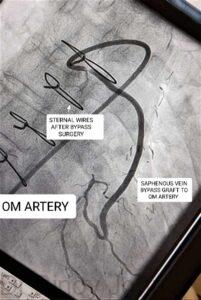
Can veins and arteries used for by-pass graft get blocked after surgery?
Just like there is a 5 – 7% chance of stents getting re-blocked, by-pass grafts can get blocked with time. This is especially so with the saphenous vein grafts (SVG). Saphenous vein grafts have a rather high attrition rate with a 30% chance of re-blocks occurring in the first three years of a by-pass surgery. However, blocks in by-pass grafts, if identified before they become completely blocked, can be successfully re-opened by angioplasty and stenting. However, once they become 100% blocked, they cannot be re-opened. Therefore, in order to detect the blocks before they become 100%, it is important to have a very close and frequent follow-up with a cardiologist, after the by-pass surgery.
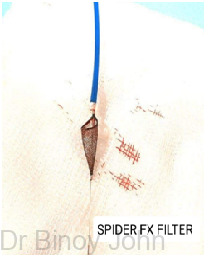
How does the DPD work?
The Spider FX filter device is a very fine net or mesh (See previous image) which can be placed deep in the vein beyond the block. Once placed beyond the block, the angioplasty and stenting can be performed safely and all the fatty material that are dislodged during the balloon dilatation and stent deployment will get trapped in the Spider FX mesh, thus preventing slow or no flow phenomenon. After a successful angioplasty andstent placement, the Spider FX along with the fatty material are captured into its sheath and removed from the graft thus achieving a good result and good flow.
The images below show the sequential steps in angioplasty of a bypass graft with a tight 99% block just at the beginning or mouth of the graft.The steps involving the by-pass graft angioplasty starts by performing an angiogram of the blocked graft. (See image) The image shows a venous graft connected to a 100% blocked OM artery done during the By-pass surgery, years ago.

The angiogram identified a very tight, 99% block at the beginning or mouth of the vein graft. (See image)
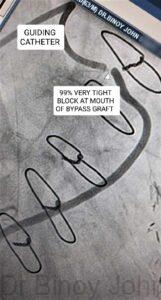
The angioplasty of this graft was planned and a wire is passed into the vein across the block. (See image)
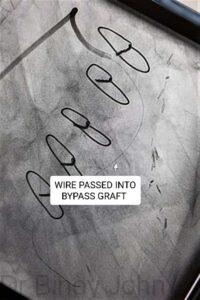
Then a DPD (Spider Fx) filter is placed beyond the block to capture the fatty material. (See Image)
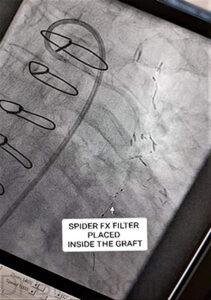
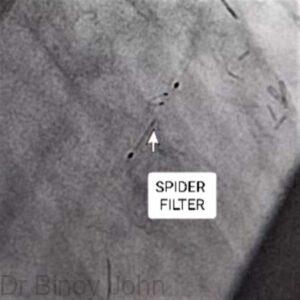
Then a balloon is positioned across the block and inflated. (See Image)
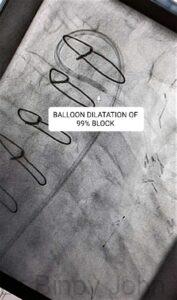
Once a good opening of the block is attained, (See Image)
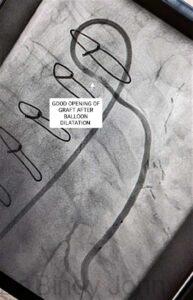
a stent is positioned and inflated to achieve complete opening of the block. (See Image)
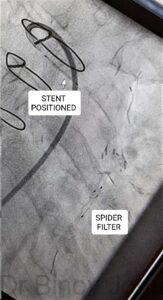
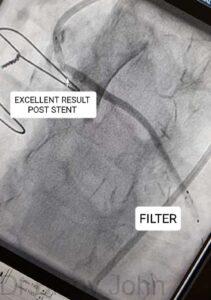
After ensuring good blood flow, the DPD is captured and removed. (See image)
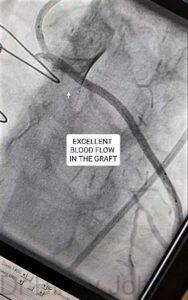
Expertise: By-pass graft angioplasty figures as a complex angioplasty and Dr Binoy John has huge experience withBy-pass graft interventions and has given expert Tips and Tricks lectures in several national and international interventional cardiology conferences.
Watch video:
Saphenous vein By-pass Graft angioplasty and stenting with the use of a Spider FX distal protection device in a 55 year old man with 99% block in SVG to Right coronary artery.
In the news! DrBinoy John on Bypass graft surgery and angioplasty:







